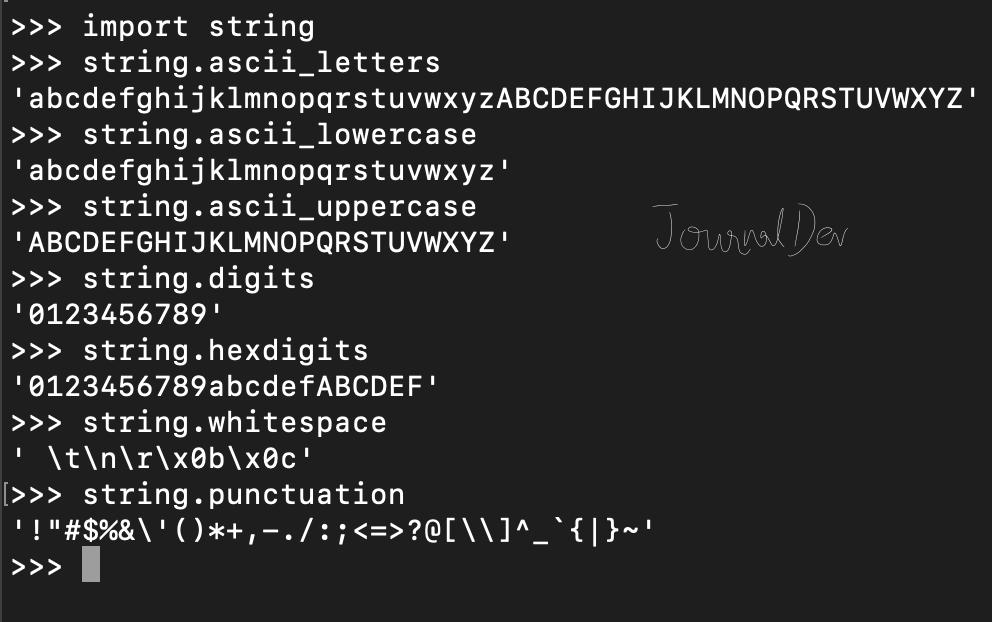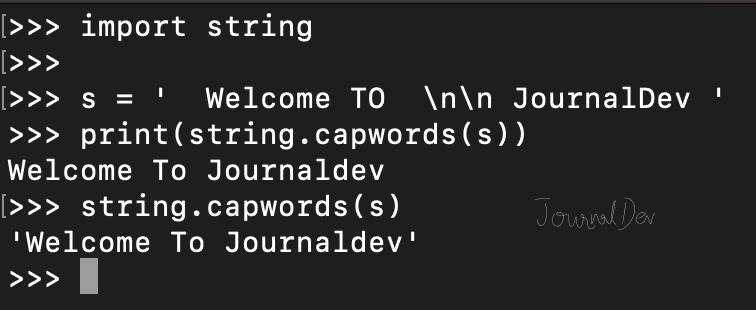Python字符串模块
·
Python String 模块包含一些常量、实用函数和用于字符串操作的类。
Python字符串模块
它是一个内置模块,我们必须在使用它的任何常量和类之前导入它。
字符串模块常量
让我们看一下字符串模块中定义的常量。
import string
# string module constants
print(string.ascii_letters)
print(string.ascii_lowercase)
print(string.ascii_uppercase)
print(string.digits)
print(string.hexdigits)
print(string.whitespace) # ' \t\n\r\x0b\x0c'
print(string.punctuation)
输出:
abcdefghijklmnopqrstuvwxyzABCDEFGHIJKLMNOPQRSTUVWXYZ
abcdefghijklmnopqrstuvwxyz
ABCDEFGHIJKLMNOPQRSTUVWXYZ
0123456789
0123456789abcdefABCDEF
!"#$%&'()*+,-./:;?@[\]^_`{|}~

字符串 capwords() 函数
Python 字符串模块包含一个实用函数 - capwords(s, sepu003dNone)。此函数使用str.split()将指定的字符串拆分为单词。然后它使用str.capitalize()函数将每个单词大写。最后,它使用str.join()连接大写单词。如果未提供可选参数 sep 或 None,则删除前导和尾随空格,并用单个空格分隔单词。如果提供,则分隔符用于拆分和连接单词。
s = ' Welcome TO \n\n JournalDev '
print(string.capwords(s))
输出:Welcome To Journaldev
Python 字符串模块类
Python 字符串模块包含两个类 - Formatter 和 Template。
格式化程序
它的行为与str.format()函数完全相同。如果你想继承它并定义你自己的格式字符串语法,这个类会变得很有用。让我们看一个使用 Formatter 类的简单示例。
from string import Formatter
formatter = Formatter()
print(formatter.format('{website}', website='JournalDev'))
print(formatter.format('{} {website}', 'Welcome to', website='JournalDev'))
# format() behaves in similar manner
print('{} {website}'.format('Welcome to', website='JournalDev'))
输出:
Welcome to JournalDev
Welcome to JournalDev

模板
此类用于为更简单的字符串替换创建字符串模板,如PEP 292中所述。在不需要复杂格式规则的应用程序中实现国际化 (i18n) 很有用。
from string import Template
t = Template('$name is the $title of $company')
s = t.substitute(name='Pankaj', title='Founder', company='JournalDev.')
print(s)
输出:Pankaj is the Founder of JournalDev.
您可以从我们的GitHub 存储库签出完整的 Python 脚本和更多 Python 示例。
参考:官方文档
更多推荐
 已为社区贡献126445条内容
已为社区贡献126445条内容







所有评论(0)